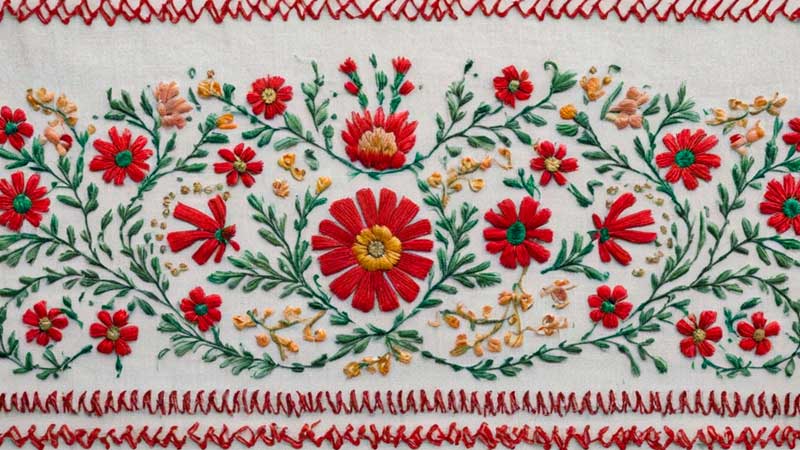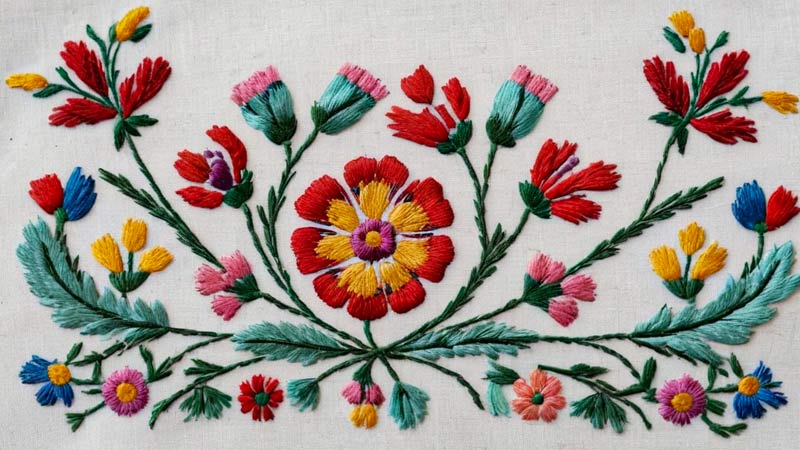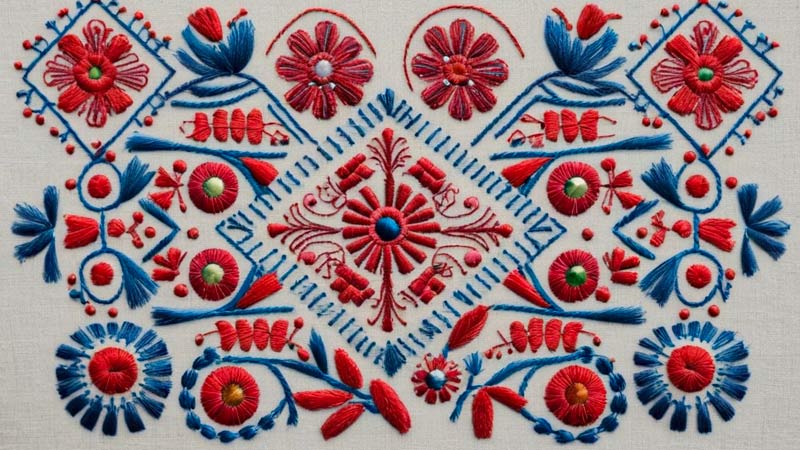Traditional Hungarian embroidery is a vibrant and intricate folk art that reflects the rich cultural heritage of Hungary.
Characterized by its bold colors, symbolic motifs, and meticulous craftsmanship, Hungarian embroidery has deep roots in the country’s history.
This traditional craft incorporates a diverse range of patterns, including floral motifs, birds, geometric shapes, and symbols of protection.
Each stitch and motif holds cultural significance, conveying stories of love, protection, and the cyclical nature of life.
Passed through generations, Hungarian embroidery is not merely decorative but a visual language that preserves the essence of rural life, spirituality, and the unique identity of different regions within Hungary.

What Is Traditional Hungarian Embroidery?
Traditional Hungarian embroidery is a vibrant and intricate folk art that has been passed down through generations, reflecting the rich cultural heritage of Hungary.
Characterized by bold colors, geometric patterns, and symbolic motifs, Hungarian embroidery is often found on traditional garments, home textiles, and decorative items.
Common elements in Hungarian embroidery include stylized floral designs, intricate borders, and the use of contrasting thread colors. The motifs often carry symbolic meanings, representing fertility, protection, or cultural identity.
Popular stitches in Hungarian embroidery include the chain stitch, satin stitch, and cross-stitch, creating a textured and visually appealing surface.
Each region in Hungary has its unique embroidery style, showcasing a diverse range of techniques and patterns.
The craft is deeply ingrained in the country’s history, with garments like the Matyó blouse or Kalocsa-style aprons serving as iconic examples.
Today, traditional Hungarian embroidery continues to be celebrated and preserved, both as a cultural heritage and a form of artistic expression.
Traditional Hungarian Embroidery Patterns
Traditional Hungarian embroidery patterns are characterized by a rich tapestry of motifs, symbols, and intricate designs that have been passed down through generations.
These patterns are not only aesthetically pleasing but also carry cultural, historical, and symbolic meanings.
Here are the traditional Hungarian embroidery patterns:
Floral Motifs

Hungarian embroidery’s floral motifs go beyond mere aesthetic appeal, each bloom carrying layers of symbolism.
The tulip, with its graceful shape, represents love and admiration. Carnations symbolize fascination and distinction, while the rose, with its timeless beauty, embodies love, passion, and the transient nature of life.
These floral elements are carefully chosen, not just for their visual appeal but to convey nuanced emotions and reflections on the human experience.
Birds
In Hungarian embroidery, birds serve as messengers of cultural beliefs and aspirations. The phoenix, rising from its ashes, symbolizes resilience, rebirth, and the cyclical nature of life.
The rooster, often featured prominently, is a protective symbol, guarding against evil spirits and bringing good fortune.
Birds in Hungarian embroidery not only add visual interest but also carry profound meanings that connect the embroidery to the broader cultural and spiritual narratives of the Hungarian people.
Animals
Depictions of animals in Hungarian embroidery, such as horses and deer, are more than just decorative elements, they are symbols deeply rooted in the country’s agricultural heritage.
Horses symbolize strength, vitality, and the indispensable role of these animals in rural life. Deer, often associated with grace and gentleness, may represent harmony with nature.
These animal motifs connect the embroidered pieces to the daily life, traditions, and values of the Hungarian people.
Geometric Shapes

Geometric patterns in Hungarian embroidery contribute to the precision and orderliness of the designs.
Diamonds, squares, and crosses are meticulously arranged to create a structured and rhythmic quality. Beyond their visual appeal, these geometric shapes may also hold symbolic significance.
Crosses, for example, may represent faith and spirituality, while diamonds could symbolize wealth and prosperity. The incorporation of these shapes enhances the overall balance and harmony of the embroidery.
Folk Motifs
Hungarian embroidery is a canvas that paints a vivid picture of rural life through traditional folk motifs. Farmhouses, sheaves of wheat, and stylized depictions of daily activities capture the essence of agrarian existence.
These motifs not only celebrate the agricultural roots of the Hungarian people but also serve as a form of storytelling, preserving and sharing the cultural heritage of rural communities.
Each stitch becomes a thread in the narrative of everyday life, creating a visual tapestry that reflects the heart of Hungarian folk culture.
Symbols of Protection

Hungarian embroidery takes on a deeper layer of significance with the incorporation of symbols meant to provide protection.
The rooster, with its bold and vigilant presence, is a powerful emblem believed to ward off evil spirits and bring good fortune to the household.
Additionally, stylized eyes, often featured in intricate patterns, are thought to possess protective and guiding qualities.
These symbols not only add a visual dimension to the embroidery but also connect the art form to the cultural practices of safeguarding homes and communities from negative forces.
Tree of Life
The Tree of Life stands as a majestic and recurring motif in Hungarian embroidery, carrying profound symbolism.
This motif represents the cyclical nature of life, fertility, and the interconnectedness of all living things.
The branches, leaves, and sometimes animals depicted within the tree create a visual narrative of continuity and growth.
Beyond its ornamental beauty, the Tree of Life serves as a powerful metaphor, emphasizing the importance of harmony and balance in the circle of life.
Border Patterns
Intricate border patterns play a crucial role in framing the central motifs of Hungarian embroidery. These borders are not merely decorative; they serve to enhance the overall design and add a sense of completion to the piece.
Geometric shapes, stylized flowers, and repeating patterns within the borders contribute to the visual appeal, creating a harmonious transition between the central elements and the surrounding fabric.
The borders showcase the meticulous attention to detail and craftsmanship inherent in Hungarian embroidery.
Color Palette
The bold and vibrant color palette of traditional Hungarian embroidery is a hallmark of its visual allure.
Red, with its multifaceted symbolism of love and life force, dominates many pieces. Black, representing protection, adds a layer of depth to the designs. Blue and white contribute to the contrast, enhancing the overall intensity of the compositions.
The careful selection and juxtaposition of these colors not only create visually striking patterns but also infuse each piece with cultural meaning and emotional resonance.
Regional Variations
Hungarian embroidery exhibits a fascinating diversity through regional variations, each style contributing to the rich tapestry of the country’s cultural heritage. Matyó embroidery, with its exuberant floral patterns, reflects the lively spirit of the Matyó region.
On the other hand, Kalocsa embroidery, known for its elaborate floral motifs, showcases the distinctive artistic expressions of the Kalocsa region.
These regional variations highlight the uniqueness of local traditions, ensuring that Hungarian embroidery is a dynamic and evolving art form that carries the essence of different communities across the country.
FAQs
What Is the Name of Hungarian Folk Art?
The name of Hungarian folk art is “Népművészet” or “Magyar Népművészet” in Hungarian.
Why is the color red prominent in Hungarian embroidery?
Red, a predominant color in traditional Hungarian embroidery, symbolizes love and the life force, adding cultural and symbolic depth to the intricate designs.
Are there regional variations in Hungarian embroidery styles?
Yes, different regions in Hungary have distinct embroidery styles, such as Matyó embroidery, known for exuberant floral patterns, and Kalocsa embroidery, featuring elaborate floral motifs, contributing to the diversity of Hungarian embroidery.
To Recap
Traditional Hungarian Embroidery is an enduring cultural treasure that weaves together history, symbolism, and artistic expression.
This folk art, with its vibrant colors, intricate patterns, and deeply rooted motifs, serves as a visual storyteller of Hungary’s cultural narrative.
Beyond its aesthetic appeal, Hungarian embroidery embodies the spirit of rural life, spirituality, and regional identity.
Preserving ancient techniques, this craft connects generations, ensuring the continuity of traditions.
As contemporary designers incorporate these patterns, Hungarian embroidery continues to bridge the past and present, showcasing its timeless beauty and cultural significance.
With every stitch, it not only adorns fabric but also threads the rich tapestry of Hungary’s diverse and storied heritage.
Leave a Reply